Austria’s property market slowing sharply
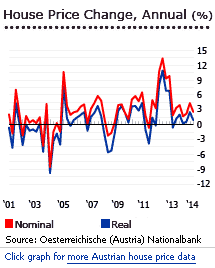 Austria’s property market is now slowing sharply, amidst meagre economic growth. The residential property price index in Austria increased modestly by 2.4% (0.7% in real terms) during the year to end-Q3 2014, based on Oesterreichische Nationalbank (OeNB)’s figures. In a quarterly basis, property prices dropped 1.2% (-1% in real terms) in Q3 2014.
Austria’s property market is now slowing sharply, amidst meagre economic growth. The residential property price index in Austria increased modestly by 2.4% (0.7% in real terms) during the year to end-Q3 2014, based on Oesterreichische Nationalbank (OeNB)’s figures. In a quarterly basis, property prices dropped 1.2% (-1% in real terms) in Q3 2014.
This overall slowdown in the housing market is reflected in almost all parts of the country.
- In Vienna, the capital, residential property price index rose by just 2.2% (0.5% in real terms) during the year to Q3 2014, the lowest growth in almost seven years. During the latest quarter, house prices in Vienna actually dropped 2.5% (-2.3% in real terms) in Q3 2014, in sharp contrast with the q-o-q growth rates of 1.3% in Q2 2014, 1.1% in Q1 2014, and 2.3% in Q4 2013.
- In the rest of Austria, residential property prices rose by only 2.6% (0.9% in real terms) from a year earlier, and actually fell by 0.5% (-0.4% in real terms) from the previous quarter.
This was supported by figures released by Statistics Austria, which showed that the overall house price index increased by just 0.7% y-o-y in Q3 2014, the lowest annual increase since it started publishing the figures in 2010.
By property type:- The average price of condominium units in Austria increased by a meagre 0.8% during the year to Q3 2014, but actually dropped 0.9% when adjusted for inflation, according to the OeNB. Quarter-on-quarter, the prices of condo units remained unchanged in Q3 2014.
- The prices of single-family houses rose by 3.7% (2% in real terms) in Q3 2014 from a year earlier, but unchanged from the previous quarter.
Residential land prices in Vienna dropped 4.6% in Q3 2014 from a year earlier. In contrast, land prices in the rest of Austria continued to increase by 5.7% over the same period.
The total number of real estate transactions in Austria rose by 10.3% in the first half of 2014 from a year earlier while the value of transactions also went up by 4.3% over the same period, based on figures published by RE/MAX and compiled from the land register by IMMOunited. This was a sharp turnaround from a 12.5% decline in the number of transactions and an 8.3% drop in the volume of transactions in 2013.
In the high-end residential market, Austrians represent about 60% of property buyers in the country while the remaining 40% are foreigners, mainly from Eastern European countries like Russia and Ukraine, said Peter Marschall of Marschall Real Estate in Vienna.
With the uncertain economic condition in Russia and the conflict in Ukraine, foreign demand of Austrian properties is expected to slow again this year. “I think this year it will not be so easy, because we are strongly influenced by the economy in Eastern Europe, and a lot of buyers come from there,” Marschall said.
Local house price variations
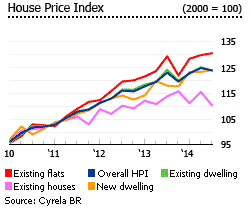
The First District, also called “Innere Stadt”, which means “Inner City”, is a UNESCO heritage site blessed with baroque architecture as well as the Imperial Palace. The First District is the center of luxury and secondary home market in Vienna. Luxury apartments currently range from about US$1,000 per square foot (sq. ft.) to more than US$3,000 for the most exclusive penthouses.
Prices tend to fall as homebuyers move away from the First District, said Alexander Koch de Gooreynd of Knight Frank. In the 13th District, west of the centre, as well as in the 18th and 19th Districts to the north, house prices range from US$4 million to US$12 million.
On the other hand, in the 2nd and 5th Districts, residential properties are sold from US$850,000 to US$2.8 million.
Divergence between Vienna and the rest of Austria

House prices in Vienna have been rising consistently since Q3 2004. During the housing boom (2003-2013), house prices in the capital soared by 99.6% (61.7% in real terms). On the other hand, property price changes in the rest of Austria have been erratic ever since the index was assembled in 2000. House prices rose by just 37.1% (11.1% in real terms) from 2003 to 2013. While both Vienna and the rest of Austria are now showing signs of slowdown, there remains a huge gap in their property price levels.
The divergence between the capital and the rest of Austria during the period is puzzling. It may be partly because it is difficult to build in the centre of Vienna. It may also be because in an era of low interest rates, people are putting money into rental properties, and Vienna offers relatively easy renting (though returns are quite moderate). Another possible factor is that the majority (about 70%) of residential real estate in Vienna is owned by institutional investors, i.e., banks and companies.
Housing supply
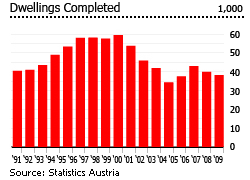
The number of new dwellings built in Austria fell to about 40,000 units a year during 2001-2004, from around 66,000 units yearly in the 1990s, as a result of a boom-and-bust cycle. Construction volumes have still not entirely recovered. Total dwellings authorized rose to 59,500 units in 2013, from 39,774 units in 2012, and 45,665 units in 2011, according to Statistics Austria. Dwelling completions also rose by more than 16% y-o-y to about 51,000 units in 2013.
In the third quarter of 2014, the total number of new building permits rose by 18% to 6,640 units from the same period last year, according to Statistics Austria. The number of dwelling units in new residential buildings increased 2% over the same period. There were about 18,600 new building permits during the first three quarters of last year.
By the start of 2014, the total housing stock in Austria had reached 4,460,504 dwellings, of which about 51% were units in multi-storey buildings while more than 46% were located in one- and two-family houses.
Better rental yields outside Vienna
Austria’s rental market is segmented via tenure, regulation and market forces into a hierarchy of low rents for municipal, other social tenants and long-term incumbents in the private sector, but higher free market rents for recent entrants into the private rental sector (though even the "free" sector is substantially controlled, with maximum rents clearly specified by the authorities). Global Property Guide’s figures cover the "free" market sector only.
Rental yields in Vienna’s Innere Stadt (Old Town) are poor as compared to the other upscale areas in Vienna, with yields ranging from only 1.44% to 2.18%, according to Global Property Guide research of August 2014. In Vienna’s other luxurious areas, rental yields range from 2.81% to 4.41%, with smaller apartments earning the highest rental returns, and bigger apartments earning the lowest rental returns.
Better yields can be found outside Vienna. Gross rental yields are the highest in Graz, ranging from 4.53% to 6.70%. The smallest apartments return the highest rental yields.
An oversupply of rental units during the 1990s led to a fall in rents. The rent decline stopped in 2000 and rents even rose briefly until 2001, but fell once more in 2002.
Residential rents are rising
Residential rents in Austria continue to rise, in contrast with the slowing house price rises in the country. During the year to end-Q3 2014, the average residential rent in Vienna rose by 5% from a year earlier, according to OeNB. Likewise in the rest of Austria, the average rent for single family houses also climbed by 7.4% y-o-y in Q3 2014 while for condominium units, rents increased 2.4% over the same period.
Innere Stadt apartments fetch one of the highest rents in Austria, ranging from EUR 18 to EUR 20 per sq. m. per month, according to according to Global Property Guide research. These have not increased in the past year. In the other upscale districts of Vienna, rents range from EUR 14 to EUR 15 per sq. m. per month.
Rents on Salzburg apartments are close to Viennese levels, at around from EUR 14.50 per sq. m. per month.
Apartments are most affordable in Graz, with rents ranging from EUR 10.50 to EUR 12.50 per sq. m. per month.
Vienna has one of the highest percentages of renter households in the world, with about 75% of homes rented in 2013. In Austria as a whole, households own 56.4% of primary residences, while 41.2% are rented, according to a recent Austrian microcensus. Austria’s home ownership rate is way below the EU-27’s average rate of more than 70%.
The high percentage of rented residential properties is due to the large proportion of subsidized low-rent apartments in the general rental market, according to Martin Schneider of the Oesterreichische Nationalbank (OeNB). Limited tax incentives for home ownership also contribute to the high proportion of renters.
Interest rates continue to fall
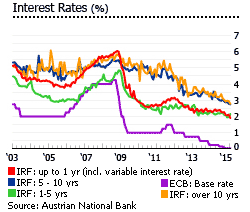
Most new housing loans in Austria are on variable rates, not fixed, making the housing market quite sensitive to interest rate changes. Indeed, the total amount of new housing loans with variable interest rates increased from 53% of all new housing in 2004, to around 82% in 2013 and finally to almost 87% in Q3 2014.
Interest rates continue to decline, following European Central Bank key rates. As of January 2015, the following average housing loan rates applied in Austria:
- Interest rate fixation (IRF) of up to 1 year: 1.91%, down from 2.26% from a year earlier and the lowest in almost two decades
- IRF over 1 and up to 5 years: 2.15%, down from 2.29% from a year earlier
- IRF over 5 years and up to 10 years: 2.75%, down from 3.07% from a year earlier
- IRF over 10 years: 2.79%, down from 3.33% from a year earlier
Following the drop in European Central Bank key rates, the variable housing loan interest rate dropped to around 4% - 4.5% from 2003 to 2006. After an uptick, variable rates further dropped to 2.75% in December 2010, amidst the global financial meltdown. The variable rates increased to 3.16% in December 2011, before falling again to 2.48% in December 2012, to 2.36% in December 2013 and to 2.11% in December 2014.
The ECB key rate is currently at its all-time low of 0.05%, after a 10-basis-points rate cuts made by the ECB both in June 2014 and in September 2014.
Austria´s mortgage market remains small
Austria has a smaller mortgage market than other European countries. Mortgage loans outstanding were 35.3% of GDP in 2013 (EUR 111.2 billion, equivalent to US$ 154.1 billion), having grown from EUR 41.1 billion (US$ 57 billion) or 19.7% of GDP in 2000. The average mortgage market size in the EU is 50% of GDP.
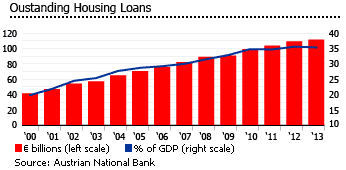
In the third quarter of 2014, the total amount of new housing loans to households rose by 5.5% from the same period last year, according to OeNB.
Mortgage growth was accompanied by an increase in foreign-currency denominated loans from around 7% of total housing loans in 2000, to 20% in 2013 and finally to more than 23% in Q3 2014.
Meagre economic growth in 2015
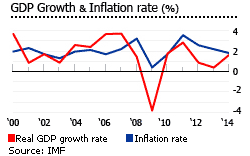
Austria’s economy was estimated to have stagnated in 2014, with real GDP growth rate of just 0.2%, after expanding by 0.3% in 2013 and 0.9% in 2012, according to the European Union (EU). The EU recently revised down its growth projections for Austria to just 0.8% this year, down from a previous forecast of 1.2%.
The Austrian economy is mainly driven by exports, mostly to its biggest trading partner, Germany. More than 75% of Austria’s exports go to Europe, 30% to Germany. Austria experienced relatively strong economic growth from 2004 to 2007 with an average annual GDP growth of 3.1%. After contracting by 3.8% in 2009, the economy emerged from recession with growth rates of 2.31% in 2010 and 2.7% in 2011.
Austria’s budget deficit was projected to be at around 2.4% of GDP last year, slightly up from 2.3% in 2013. The budget deficit is projected to decline to 1.8% of GDP in 2015 and to 1.4% in 2016, according to the OeNB.
The country’s overall unemployment rate stood at 5.1% last year, but is expected to increase to 5.3% this year.
In January 2015, the country’s annual inflation rate stood at 0.5%, down from 0.8% in the previous month, according to Eurostat . However, this was higher than the EU’s average inflation of -0.6% in January 2015. Austria’s inflation rate averaged 2.3% from 2010 to 2014, according to the IMF.